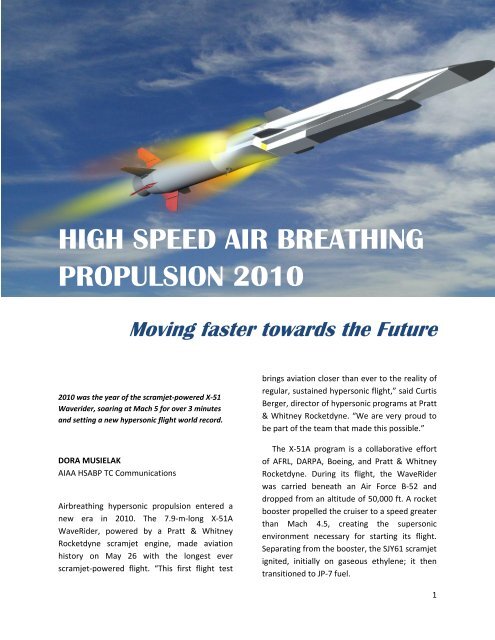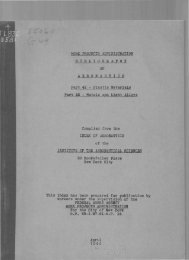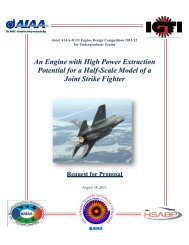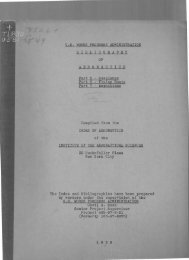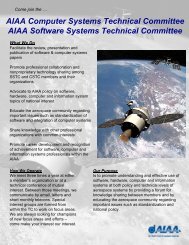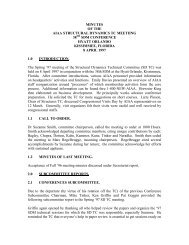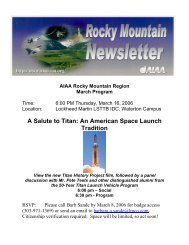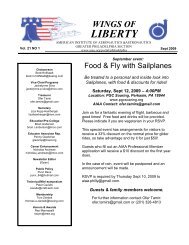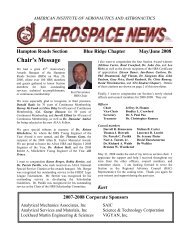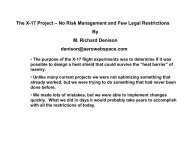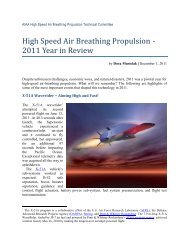HIGH SPEED AIR BREATHING PROPULSION 2010 - AIAA Info
HIGH SPEED AIR BREATHING PROPULSION 2010 - AIAA Info
HIGH SPEED AIR BREATHING PROPULSION 2010 - AIAA Info
Create successful ePaper yourself
Turn your PDF publications into a flip-book with our unique Google optimized e-Paper software.
<strong>HIGH</strong> <strong>SPEED</strong> <strong>AIR</strong> <strong>BREATHING</strong><br />
<strong>PROPULSION</strong> <strong>2010</strong><br />
Moving faster towards the Future<br />
<strong>2010</strong> was the year of the scramjet‐powered X‐51<br />
Waverider, soaring at Mach 5 for over 3 minutes<br />
and setting a new hypersonic flight world record.<br />
DORA MUSIELAK<br />
<strong>AIAA</strong> HSABP TC Communications<br />
Airbreathing hypersonic propulsion entered a<br />
new era in <strong>2010</strong>. The 7.9‐m‐long X‐51A<br />
WaveRider, powered by a Pratt & Whitney<br />
Rocketdyne scramjet engine, made aviation<br />
history on May 26 with the longest ever<br />
scramjet‐powered flight. “This first flight test<br />
brings aviation closer than ever to the reality of<br />
regular, sustained hypersonic flight,” said Curtis<br />
Berger, director of hypersonic programs at Pratt<br />
& Whitney Rocketdyne. “We are very proud to<br />
be part of the team that made this possible.”<br />
The X‐51A program is a collaborative effort<br />
of AFRL, DARPA, Boeing, and Pratt & Whitney<br />
Rocketdyne. During its flight, the WaveRider<br />
was carried beneath an Air Force B‐52 and<br />
dropped from an altitude of 50,000 ft. A rocket<br />
booster propelled the cruiser to a speed greater<br />
than Mach 4.5, creating the supersonic<br />
environment necessary for starting its flight.<br />
Separating from the booster, the SJY61 scramjet<br />
ignited, initially on gaseous ethylene; it then<br />
transitioned to JP‐7 fuel.<br />
1
The achievement is significant, because this<br />
is the first hypersonic flight by a hydrocarbon‐<br />
fueled scramjet. “We are ecstatic to have<br />
accomplished many of the X‐51A test points<br />
during its first hypersonic mission,” declared<br />
Charlie Brink, X‐51A program manager with<br />
AFRL. Brink called the leap in engine technology<br />
“equivalent to the post‐WW II jump from<br />
propeller‐driven aircraft to jet engines.”<br />
On that historic day, the X‐51 launched about<br />
10 a.m. from Edwards Air Force Base, carried<br />
aloft under the left wing of an Air Force Flight<br />
Test Center B‐52 Stratofortress. Then, flying at<br />
50,000 ft. over the Pacific Ocean Point Mugu<br />
Naval Air Warfare Center Sea Range, it was<br />
released. Four seconds later, an Army Tactical<br />
Missile solid rocket booster accelerated the X‐<br />
51 to about Mach 4.8 before it and a connecting<br />
interstage were jettisoned.<br />
The launch and separation were normal.<br />
Then the SJY61 scramjet engine ignited, initially<br />
on a mix of ethylene and JP‐7 jet fuel, then<br />
exclusively on JP‐7 jet fuel, the same fuel once<br />
carried by the SR‐71 Blackbird. The hypersonic<br />
demonstrator vehicle reached an altitude of<br />
about 70,000 feet and a peak speed of Mach 5.<br />
The vehicle's fuel‐cooled engine, circulating<br />
270 pounds of fuel serves both to heat the JP‐7<br />
to an optimum combustion temperature and to<br />
help the engine itself endure extremely high<br />
operating temperatures during the long burn.<br />
Without such active cooling, the temperatures<br />
in the scramjet could reach 5,000°F, high<br />
enough to melt virtually any metal on Earth.<br />
Solving the cooling challenge is a major<br />
AFRL/Pratt & Whitney achievement.<br />
The much anticipated hypersonic flight did<br />
not reach its maximum hypersonic speed and it<br />
flew autonomously for only 200 seconds before<br />
losing acceleration—its scramjet is designed for<br />
Mach 6 and burn for 300 seconds. But as stated<br />
by Joe Vogel, Boeing Director of Hypersonics<br />
and X‐51A Program Manager, "This is a new<br />
world record and sets the foundation for<br />
several hypersonic applications, including<br />
access to space, reconnaissance, strike, global<br />
reach and commercial transportation."<br />
The unmanned X‐51A WaveRider, powered by the<br />
P&W Rocketdyne SJY61 scramjet engine, is designed<br />
to ride on its own shockwave.<br />
The X‐51A WaveRider was launched from beneath<br />
the wing of a B‐52.<br />
2
We must add that this achievement is also<br />
quite significant, as it is the first hypersonic<br />
flight by a hydrocarbon‐fueled scramjet.<br />
Hydrogen‐fueled scramjets have achieved<br />
much higher speed. In fact, the previous record<br />
was set by NASA's X‐43A, when its hydrogen‐<br />
fueled scramjet engine burned for about 12<br />
seconds in 2004; that experimental hyper‐<br />
vehicle zoomed to Mach 9.8. And as much as<br />
we like the clean burning of hydrogen, for some<br />
applications, such as fighter aircraft and<br />
missiles, hydrocarbon fuels are desired.<br />
The successful flight of the first X‐51A<br />
demonstrated the viability of hypersonic<br />
vehicles. The advanced technologies in this<br />
program is bound to stimulate the development<br />
of hypersonic missiles and other military aircraft<br />
in the near future, platforms able to travel long<br />
distances quickly and close in on their targets so<br />
fast they would be almost impossible to defend<br />
against.<br />
The X‐51A might also revive interest in hybrid<br />
turbo‐scramjet engines, propulsion concepts<br />
integrated into a new hypersonic vehicle that<br />
would not depend on a booster rocket to<br />
operate at the lower flight speeds. For example,<br />
it might be possible to get the scramjet to light<br />
up initially at speeds low enough to be<br />
integrated with a regular afterburning turbojet<br />
or with a detonation engine‐turbine hybrid<br />
rather than booster rockets.<br />
Such approaches would widen the prospects<br />
for a number of applications including military<br />
jets and reusable spaceplanes. For example, a<br />
hypersonic jet fighter could take off from a<br />
runway and accelerate to scramjet ignition<br />
speed using an advanced jet engine, then<br />
switch into scramjet mode and rush forward<br />
into the hypersonic regime. This would<br />
essentially be a modern, hypersonic update of<br />
the incomparable SR‐71 turbo/ramjet spyplane,<br />
the famous Mach‐3.5 Blackbird.<br />
The performance of a turbo‐scramjet could<br />
be further enhanced by the addition of a<br />
detonation combustion augmenter for the<br />
supersonic flight regime. This is because the<br />
efficiency of the jet engines that powers today’s<br />
military vehicles has approached its limit. But<br />
detonation combustion offers the needed<br />
performance improvement, resulting in a more<br />
efficient propulsion system that could extend<br />
vehicle range, cut fuel costs and reduce<br />
emissions. Engineers at GE Global Research, for<br />
example, have designed and built an eight‐<br />
combustor version of a pulse detonation engine<br />
(PDE) and integrated it with a conventional<br />
turbine. This development effort is needed to<br />
understand how to integrate a PDE in a real gas<br />
turbine engine.<br />
Having an efficient detonation engine‐<br />
turbine‐scramjet, by integrating a rocket would<br />
allow a spaceplane to take off from a runway,<br />
gain the necessary speed and altitude still in the<br />
air‐breathing mode, and then make the final<br />
climb and acceleration to Mach‐25 orbital<br />
velocity in the rocket mode. This would result in<br />
a single‐stage to orbit spaceplane, one that<br />
would carry significantly less oxidizer than<br />
conventional two‐stage rockets.<br />
Aerojet also made progress on advancing<br />
scramjet technology in <strong>2010</strong>. Under contract<br />
with the U.S. Air Force Research Laboratory<br />
(AFRL), the company completed ground testing<br />
of a scramjet combustor, demonstrating a new<br />
thermal management technique. Called core<br />
burning, it forces the combustion flames away<br />
from engine surfaces, thereby reducing overall<br />
heat load. According to Aerojet’s patent by<br />
Melvin Bulman, with core burning “a pilot for a<br />
3
scramjet provides a flame front whose arrival at<br />
the wall of the scramjet combustor is delayed<br />
thereby reducing combustor heat load. By<br />
combining in‐stream injection of fuel with an<br />
interior pilot and a lean (fuel‐poor) outer<br />
annulus, the bulk of combustion is confined to<br />
the scramjet combustor center. One such pilot<br />
is for a two dimensional scramjet effective to<br />
propel a vehicle. This pilot includes a plurality of<br />
spaced apart struts separated by ducts and a<br />
strut pilot contained within each strut. A second<br />
such pilot is for an axisymmetric scramjet<br />
engine has, in sequence and in fluid<br />
communication, an air intake, an open bore<br />
scramjet isolator and a scramjet combustor.”<br />
Aerojet’s engineers expect that core burning<br />
will require less fuel to cool the engine,<br />
enabling scramjets to have more thermal<br />
margin and to fly faster than with conventional<br />
thermal management. During the tests, the<br />
engine operated robustly at simulated Mach 3<br />
to 5 flight conditions and at various simulated<br />
altitudes and fuel injection settings. An Air<br />
Force‐provided video camera recorded views of<br />
the combustion process clearly showing the<br />
flame holding and flame propagation processes<br />
occurring from the combustor center, thereby<br />
proving the core burning concept..<br />
Aerojet’s core burning technology overcomes<br />
the long‐standing challenge of flight speed<br />
limiting thermal loads in the combustor. This<br />
thermal management technique will be crucial<br />
as the Air Force looks to progress from<br />
“laboratory” engine scales to those of<br />
operational sizes for long‐range, time‐critical<br />
missiles and high‐speed military aircraft.<br />
In <strong>2010</strong> Pratt & Whitney Rocketdyne and<br />
Lockheed Martin also completed preliminary<br />
design of an actively cooled Dual Mode Ramjet<br />
combustor in support of the DARPA funded<br />
Mode Transition (MoTr) Demonstrator<br />
Program. This program seeks to ground test a<br />
turbine‐based combined‐cycle (TBCC) engine<br />
using hydrocarbon fuel. The MoTr program will<br />
demonstrate transition from turbojet to<br />
ramjet/scramjet cycle, the critical experiment<br />
required to enable reusable, air‐breathing,<br />
hypersonic flight. MoTr leverages previous and<br />
on‐going advances in air‐breathing propulsion<br />
technology, including the Falcon Combined‐<br />
cycle Engine Technology (FaCET) and the Air<br />
Force/DARPA High Speed Turbine Engine<br />
Technology Demonstration (HiSTED) program.<br />
The MoTr program will provide valuable risk<br />
reduction for future flight test program<br />
opportunities.<br />
Aerojet’s Supersonic Sea‐Skimming Target<br />
ramjet propulsion system successfully<br />
completed the first flight test of the Coyote<br />
High Diver supersonic target mission. The target<br />
vehicle, developed by Orbital Sciences<br />
Corporation with Aerojet’s solid‐fueled Variable<br />
Flow Ducted Rocket (VFDR) engine, was rail‐<br />
launched from the ground and boosted by a<br />
rocket motor to ramjet‐takeover speed. Under<br />
ramjet power, the system ascended to 35,000 ft<br />
and reached Mach 3.3 cruise speed. At the end<br />
of its 110 nautical‐mile‐long flight, the vehicle<br />
executed a planned 40‐degree unpowered dive<br />
to its objective.<br />
The international community pushed<br />
forward air breathing hypersonics as well.<br />
Leading countries such as Australia, Brazil,<br />
France, Japan, and Russia made significant<br />
contributions to advance several technologies.<br />
The following paragraphs provide highlights of<br />
the progress made by other nations in <strong>2010</strong>.<br />
4
Brazilian interest on Highspeed<br />
Airbreathing Propulsion<br />
The Institute for Advanced Studies (IEAv), a<br />
research center of the Brazilian Command of<br />
Aeronautics, is developing two advanced high‐<br />
speed air‐breathing propulsion technologies.<br />
The IEAv’s Hypersonic Aerospace Vehicle,<br />
named 14‐X (after the 14‐Bis developed by<br />
aviation pioneer Alberto Santos Dumont),<br />
initiated in 2005, is the first Brazilian project<br />
Brazil’s Waverider Hypersonic Vehicle model<br />
installed in the test section of the T3 Hypersonic<br />
Shock Tunnel.<br />
Brazil’s Hypersonic Aerospace Vehicle 14-X.<br />
with the objective to design, develop, construct<br />
and demonstrate a Mach 10 waverider in free<br />
flight with its required scramjet technology.<br />
The Mach 10 waverider Hypersonic Vehicle<br />
model was experimentally investigated in<br />
Brazil’s T3 Hypersonic Shock Tunnel of the Prof.<br />
Henry T. Nagamatsu Laboratory of<br />
Aerothermodynamics and Hypersonics.<br />
Brazil’s IEAv is also developing the<br />
Hypersonic Aerospace Vehicle, named DVPL<br />
(Vehicle Demonstrator of Laser Propulsion).<br />
IEAv Prof. Henry T. Nagamatsu Laboratory of<br />
Aerothermodynamics and Hypersonics.<br />
5
Hypersonic Aerospace Vehicle DVPL (left). 2-D laser propulsion model installed in the test section of the T3<br />
Hypersonic Shock Tunnel. Montage of the schlieren frames (left to right) for Mach 10 hypersonic flow and 1 GW<br />
laser power (time between frames 10 μs)<br />
Initiated in 2008 and in collaboration with the<br />
U.S. Air Force Office of Scientific Research’s, the<br />
DVPL is the first Brazil‐USA Laser Propulsion<br />
Experiment with the objective to design,<br />
develop, construct and demonstrate in free<br />
flight laser propulsion technology.<br />
A 2‐D Mach number 10 Laser Propulsion<br />
Vehicle model designed and built by Prof. Leik<br />
N. Myrabo from Rensselaer Polytechnic<br />
Institute (Troy, NY), was experimentally<br />
investigated in the T3 Hypersonic Shock Tunnel<br />
(HST). Additional testing is expected in 2011.<br />
Hypersonics Progress in France<br />
France has a legacy of hypersonic air breathing<br />
propulsion system assessments and technology<br />
development dating back to the 1980s. In <strong>2010</strong>,<br />
MBDA and the French National Aerospace<br />
Research Establishment (ONERA) pursued their<br />
6
R&T effort related to hypersonic air breathing<br />
propulsion mainly thanks to French State<br />
support but also with limited support from<br />
European Union.<br />
MBDA and ONERA are to receive by the end<br />
of <strong>2010</strong>, from French Administration, the<br />
contract covering all the remaining part of their<br />
flight testing program LEA. The goal of the LEA<br />
program is to establish, apply and validate a<br />
methodology for development of hypersonic air<br />
breathing vehicles. The LEA experimental<br />
vehicle should be flight tested in timeframe<br />
2013‐2015 in the Mach number range 4 to 8 by<br />
using existing Russian supersonic bomber, liquid<br />
rocket booster and test range.<br />
ONERA‐MBDA LEA vehicle<br />
The first test series have been achieved in<br />
the new METHYLE test facility providing<br />
capability to simulate up to Mach 7.5 flight<br />
conditions for large scale direct connected pipe<br />
test with test duration up to 1000s. In parallel,<br />
the upgrade of the ONERA S4Ma wind tunnel<br />
has been pursued to provide a large scale Mach<br />
6 free jet test capability which will be used for<br />
LEA program in spring 2011.<br />
Design activities were performed in the<br />
frame of the European LAPCAT2 studies related<br />
to high speed transport system. MBDA and<br />
ONERA contributed to the design challenge of a<br />
Mach 8 system.<br />
Hypersonics Advances in Japan<br />
JAXA (Japan Aerospace Exploration Agency)<br />
conducted RBCC model combustion<br />
experiments at Mach 11 conditions in the High<br />
Enthalpy Shock Tunnel (HIEST), following sea‐<br />
level static, Mach 4 and Mach 6 tests. The<br />
rocket engine in the RBCC produces most of the<br />
thrust, while the supersonic combustion engine<br />
assists in production of thrust. A detonation<br />
tube was used in the test to supply large<br />
amount of combustion gas as rocket exhaust in<br />
a short period.<br />
Inside JAXA’s M11 experimental RBCC model. It has<br />
two rocket nozzles, connecting to a detonation tube<br />
by a pipe below.<br />
JAXA’s horizontal firing test of pre‐cooled turbojet<br />
engine<br />
7
JAXA’s vertical firing test of pre‐cooled turbojet<br />
engine<br />
Researchers at JAXA also plan a Mach 2 flight<br />
experiment of the hypersonic pre‐cooled<br />
turbojet engine model using a stratospheric<br />
balloon. Ground firing tests were already<br />
conducted with both horizontal and vertical<br />
attitude to evaluate the effect of gravity force in<br />
a free‐fall flight. The starting characteristics of<br />
the air‐intake were also obtained in a<br />
supersonic engine test facility.<br />
Russia Hypersonics Success<br />
Successful tests of a large‐scale scramjet model‐<br />
demonstrator integrated with an airframe<br />
simulator of an experimental hypersonic flying<br />
vehicle (HFV) were run for the first time at the<br />
Central Institute of Aviation Motors, Russia, in<br />
April, <strong>2010</strong>. The tests were conducted within<br />
the framework of the Federal Research Program<br />
(FRP) “National Technological Base” (NTB).<br />
The demonstrator tests followed successful<br />
complex thermo‐gasdynamic studies of small<br />
scale integrated models of HFV “propulsion +<br />
airframe” and their components, as well as<br />
launching tests of a powerful high‐altitude<br />
hypersonic rig of 1.2 m nozzle diameter at the<br />
end of March, <strong>2010</strong> during its technical<br />
upgrading within the framework of FRP “NTB”.<br />
The exhauster machines of altitude‐compressor<br />
station provide for vacuum in the rig working<br />
section. A generator of high‐enthalpy air flow<br />
made within a state contract with the Rosnauka<br />
produces the required total working gas<br />
parameters appropriate to flight hypersonic<br />
speeds. The rig allows studying the working<br />
process in integrated experimental “engine +<br />
HFV” objects with simulation of hypersonic<br />
flight conditions.<br />
Russia’s HFV Model<br />
Tested rig model was displayed in the International<br />
Aerospace Salon MAKS‐2009<br />
8
Scramjets/Rocketpowered<br />
Space Launchers<br />
Engineers at NASA KSC proposed a scramjet‐<br />
powered vehicle that can be rail‐launched all<br />
the way to orbit<br />
In the proposed 10‐year plan, a wedge‐<br />
shaped vehicle powered by a scramjet engine is<br />
launched horizontally along an electrified track,<br />
or gas powered sled, carrying a pod or<br />
spacecraft destined for low Earth orbit (LEO).<br />
The scramjet would fly the vehicle to Mach 10<br />
to reach the upper edge of the atmosphere<br />
where a small rocket would fire off and propel<br />
the vehicle into orbit. The hypersonic craft<br />
would come back and land on a runway by the<br />
launch site.<br />
The so called Advanced Space Launch<br />
System, comprised of railgun, scramjet, and<br />
rocket, was recently unveiled by Stan Starr,<br />
branch chief of the Applied Physics Laboratory<br />
at Kennedy in Florida. He indicated that the<br />
system counts on the availability of a number of<br />
existing technologies. His team is already<br />
working on a rail launcher using gas propulsion,<br />
and they are applying for funding under several<br />
areas, including NASA’s technology innovation,<br />
to develop and further mature the needed<br />
technologies. If successful, this new launch<br />
approach can revolutionize access to space.<br />
There are some technical challenges to<br />
overcome first. According to the NASA team, to<br />
launch on an electrified track, for instance, the<br />
track would have to withstand at least 10 times<br />
the speeds commonly seen on tracks used for<br />
roller coasters. Roller coasters typically run<br />
about 60 mph (100 km/h).<br />
Electrified rail assist to Mach 1.5 (NASA image courtesy of S. Starr, KSC)<br />
9
Proposed NASA eLauncher Configuration (Ref. S. Starr, NASA KSC)<br />
NASA is also investigating other methods of<br />
powering a track‐launched vehicle. Engineers<br />
with NASA’s Marshall Space Flight Center in<br />
Huntsville, AL, have already tested a prototype<br />
track‐based system that uses magnetic<br />
levitation to accelerate vehicles to launch<br />
speeds.<br />
There are several studies underway to<br />
examine new launch architectures. The USAF,<br />
for example, is looking for architectures to<br />
eventually replace the existing EELV’s (Delta IV<br />
and Atlas V) which involve vertical rocket launch<br />
of a hypersonic stage. DARPA is studying<br />
scenarios that involve runway take off. All of<br />
these studies are based on the belief that<br />
practical scramjet propulsion is going to provide<br />
a design alternative in the 20‐year time frame<br />
so that reusable air breathing launch stages can<br />
be built and used routinely. The question seems<br />
to be, “what launch architecture optimizes the<br />
contribution by air breathing?” We know that<br />
the final stage into orbit has to be a rocket. We<br />
also know that the higher the initial velocity,<br />
the lower the mass of the air breathing<br />
propulsion system. For example an integrated<br />
vehicle taking off from a runway will require<br />
large low speed turbines in addition to high<br />
speed turbines, ram and scramjet engines (a lot<br />
of engines). According to Stars, if we can launch<br />
a vehicle from a rail with an initial velocity of<br />
Mach 0.5 we can decrease the size of the low<br />
speed turbines, but they are still required<br />
(although we do save propellant, wing mass,<br />
landing gear mass and other benefits). If we<br />
launch at Mach 1.5 we can launch with high<br />
speed turbines plus RAM/SCRAM. We also incur<br />
high dynamic pressures (increased structural<br />
mass) and environmental effects from sonic<br />
boom.<br />
So Starr’s basic concept is to launch at a<br />
higher velocity than previous studies<br />
considered, thereby significantly simplifying the<br />
propulsion system and reducing weight. Of<br />
course those benefits must be weighed against<br />
a more complex total system (track) and the<br />
associated costs.<br />
As for the scramjets, KSC engineers will draw<br />
from the experience gained through recent<br />
scramjet flight demonstration testing, including<br />
NASA’s X‐43A and the U.S. Air Force’s X‐51,<br />
both of which have shown that scramjets can<br />
10
achieve the required speeds for the proposed<br />
rail launcher.<br />
Starr and his NASA KSC engineering team<br />
proposed a 10‐year plan that would begin with<br />
launching a drone similar to those used in the<br />
ongoing Air Force tests. More‐advanced models<br />
would then follow, with the goal of developing<br />
a vehicle that can launch a small satellite into<br />
orbit.<br />
The proposed Advanced Space Launch<br />
System is not meant to replace NASA’s space<br />
shuttle fleet, which is schedule to retire next<br />
year, or any other manned spacecraft program,<br />
Starr said. But if this system is proven successful<br />
for unmanned launches, Starr believes that it<br />
could eventually be adapted to carry<br />
astronauts.<br />
Finally we must add that not only do we<br />
need to advance hypersonic air breathing<br />
propulsion for hypersonic missiles, military<br />
superfast vehicles, and reusable Earth‐to‐space<br />
launchers, now we must work to develop<br />
vehicles that can move at hypersonic speeds in<br />
extraterrestrial planetary atmospheres.<br />
In fact, NASA expects more research in this<br />
area and amended its announcement,<br />
“Research Opportunities in Aeronautics <strong>2010</strong>,”<br />
to include new topics in support of the agency’s<br />
Hypersonics Project.<br />
With the amendment, the Hypersonics<br />
Project of the Fundamental Aeronautics<br />
Program calls for proposals about enabling<br />
technologies and development of a new pool of<br />
expertise in two primary areas of interest.<br />
These include air‐breathing access to space and<br />
entry, descent and landing of high‐mass<br />
vehicles in planetary atmospheres.<br />
Looking Ahead<br />
The complex requirements of faster vehicles<br />
will continue to demand advancements in<br />
hypersonic propulsion. The spectacular flight of<br />
the X‐51A waverider brought scramjet<br />
technology a major step closer to practical<br />
reality, getting farther into the future.<br />
Acknowledgements<br />
The author is grateful to the following<br />
people for providing information for this<br />
article:<br />
• Nancy Colaguori, Pratt & Whitney<br />
Rocketdyne<br />
• Tim O’Brien, Aerojet<br />
• Stan Starr, NASA KSC<br />
• Paulo Gilberto de Paula Toro, IEAV,<br />
Brazil<br />
• Takeshi Kanda, JAXA, Japan<br />
• Francois Falempin, MBDA, France<br />
• V. Vinogrodov, CIAM, Russia<br />
More information about the activities of the<br />
<strong>AIAA</strong> High Speed Air Breathing Propulsion<br />
Technical Committee (HSABP TC) at<br />
https://info.aiaa.org/tac/PEG/HSABPTC/default.<br />
aspx<br />
11


